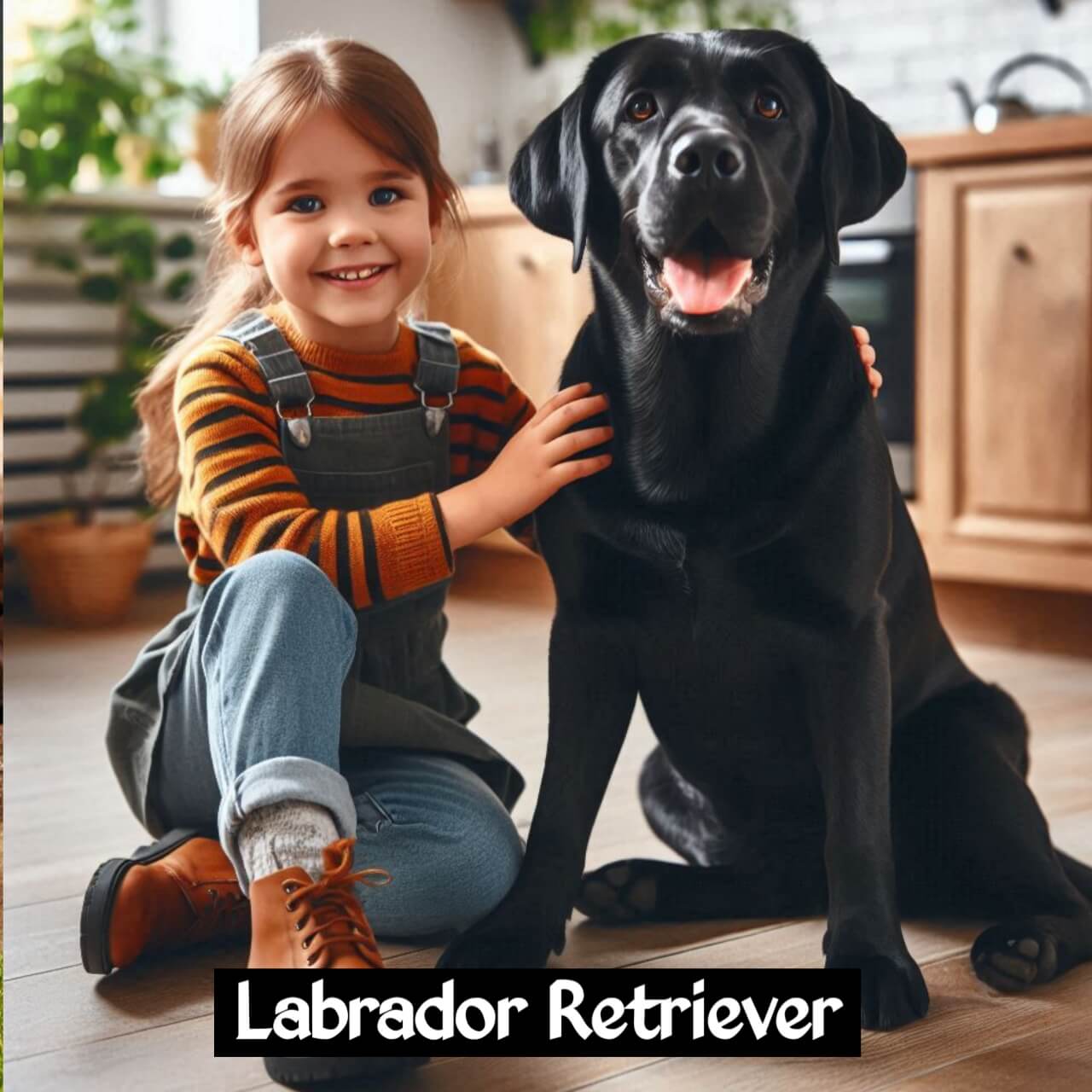Labrador Retriever
Everything You Need to Know About Labrador Retrievers

Introduction of Labrador Retriever Dog
Overview of the Labrador Retriever breed:
1. Origin: This breed of dog developed in Newfoundland, Canada as a fishing and hunting companion, Labrador Retrievers were later refined in England. This breed of dog is named after the Labrador Sea.
2. Appearance:
Size: This dog is medium to large in size, males typically weigh 65-80 pounds (29-36 kg), while females weigh 55-70 pounds (25-32 kg).
Coat: The coat of this breed of dog is characterized by a short, dense, water-resistant double coat. This dog comes in three colors: black, yellow and chocolate labrador retriever mix .
3. Temperament: This dog is known for its friendly, sociable nature. Labradors are intelligent, eager to please and generally good-natured with children and other animals.
4. Activity Level:
High Energy: Labradors are known to be active dogs that require regular exercise to stay healthy and happy.
Exercise Needs: Daily walks, play and mental stimulation are a must for this dog to prevent boredom and behavioral problems.
5. Trainability:
Highly Trainable: Labradors are intelligent and respond well to positive reinforcement training methods.
Known For: These dogs have a tendency to learn obedience commands easily and excel in activities like obedience trials and agility.
6. Health Considerations:
Common Problems: Dogs of this breed are prone to obesity, hip dysplasia, elbow dysplasia and progressive retinal atrophy (PRA).
Lifespan: Generally these dogs live up to 10-12 years, however well-cared-for Labradors can live longer if they are well taken care of.
History and Origin of Labrador Retrievers:

Origin in Newfoundland: Labrador Retrievers are believed to have originated in Newfoundland, Canada during the 18th century. The breed was initially bred as working dogs to assist fishermen in retrieving fish and nets from the icy waters of the North Atlantic.
Development in England: In the 19th century, Labrador Retrievers were imported to England, where they were developed as hunting and retrieval dogs by British aristocracy and sportsmen. They were particularly loved for their excellent swimming abilities, retrieval skills, and gentle temperament. Due to these characteristics, people have a special attraction towards this dog which still remains all over the world, that is why the demand for this dog is very high all over the world.
Breed Identity: Historians believe that the breed was officially recognized by the Kennel Club in England in 1903 and by the American Kennel Club (AKC) in 1917. That is why since then, Labrador Retrievers have gained immense popularity as versatile and reliable companions who excel in a variety of roles such as hunting, service work, search and rescue, and beloved family pets.
Modern Role: Today, Labrador Retrievers are one of the most popular dog breeds around the world, known for their friendly behavior, intelligence, and loyalty. This is the reason why this dog, which has gained popularity all over the world, has settled in the minds of almost all dog lovers who are attracted to keep it. They are in high demand as both working dogs and loving companions, embodying the ideal blend of athleticism and affection.
From the early history of the Labrador Retriever, i.e., their origins in Canada to their widespread popularity today, this dog attracts people and is also known as a well-behaved dog, golden labrador retriever which is very easy to train and follow, which makes the historical journey of Labrador Retrievers an exciting and interesting one. People see more popularity towards this dog, which is why even today this dog is considered different and social dog from other dog breeds all over the world.
Physical Characteristics

Characteristics of Labrador Retrievers are as follows:
1. Friendly and Friendly: It is generally seen that Labs are known for their friendly and sociable nature, which makes them excellent companions and family pets. labrador retriever personality Due to these characteristics, this dog is the first choice of people as a pet dog around the world.
2. Intelligent: According to a survey, it has been seen that they are generally highly intelligent dogs, which contributes to their trainability and suitability for various roles such as service dogs, therapy dogs and hunting companions. This characteristic attracts any dog owner. Due to these reasons, there is a high demand for this dog in the country and around the world.
3. Energetic: Labs are generally energetic dogs that require regular exercise and mental stimulation to keep them happy and healthy. You can keep your dog excited and energetic through a variety of activities. Keep this in mind as the dog praised by Malik is a perfect choice as a good pet.
4. Good with children: These dogs are generally seen to be good with children and other pets, often displaying a gentle and tolerant demeanor.
5. Loyal: Labs are known for their loyalty to their owners and families, forming strong bonds with those they love. This bond of friendship and strength sets them apart from other dogs and is why anyone who gets a dog makes it a priority.
6. Versatile: They usually excel in a variety of activities including retrieving, obedience, agility, and working dogs due to their athleticism and versatility. This trait makes this dog stand out from other breeds.
7. Affectionate: Labs are affectionate dogs that love to be around people and are popular for their loving nature.
8. Adaptable: These dogs usually adapt well to different living situations, whether it is a suburban home with a yard or living in an apartment, as long as their exercise needs are met.
9. Love the water: Labrador retrievers have a natural love of water, thanks to their history as water dogs bred to retrieve prey from water. These types of dogs are seen playing in water as well as taking interest in other water-related activities.
10. Low Maintenance Coat: They have a short, dense coat that is easy to care for with regular brushing to keep shedding to a minimum which is one of the main characteristics that makes these dogs so sought after.
11. Food Motivated: Labradors are often food motivated, which can aid in training, but it also means they can be prone to overeating if not monitored so paying attention to your dog regularly can be a good option for its health and as a companion.
12. Playful: A survey found that these dogs maintain a playful behavior throughout their lives, often enjoying games and toys well into adulthood which thrills people.
Temperament and Behavior

Early socialization helps in developing a full-fledged adult dog. Socialization is seen in these types of dogs. Introduce them to different people, animals, environments and experiences so that these dogs can become more social.
Exercise and Training Needs

Here are some points on Labrador Retriever training:
1. Early Socialization: You should start socializing your pet Labrador Retriever puppy early (between 3-16 weeks of age) so that they are introduced to different animals, environments, people, and situations. This early socialization process helps prevent fear in the dog and promotes good behavior so that the dog becomes well behaved as a pet dog.
2. Positive Reinforcement: Use positive reinforcement techniques like treats, praise, and play to encourage the dog to perform desired behaviors like sitting, staying, coming when called, etc. Rewarding good behavior helps reinforce it and through this process the dog becomes a good pet.
3. Consistency: Be consistent in your training methods and expectations and use the same cues and rewards constantly so that your Labrador dog listens to you well and behaves accordingly.
4. Basic Commands: It is essential for any pet dog that its owner teaches it essential commands such as sit, stay, come, heel and leave it. These commands provide the foundation for good manners and safety which is considered good for the dog and is a positive step for your safety as well.
5. Obedience Classes: Consider enrolling your Labrador Retriever in obedience classes or working with a professional trainer as many times the dog owner is not able to train the dog properly, so seek the help of a professional trainer if it is available. These classes can provide structured training and help address specific behavioral issues that teach the dog to behave as a good pet dog.
6. Exercise and Mental Stimulation: Labradors are intelligent and energetic dogs that need both physical exercise and mental stimulation. Include daily walks, playtime, and interactive toys to keep them busy and prevent boredom-related behaviors. Repeat this process every day so that the dog develops behavioral understanding.
7. Patience and Persistence: It is true that training takes time and patience. Be patient with your Labrador and be firm in reinforcing the desired behavior. Consistency and repetition are important for successful training which is considered good for the pet and friendly nature of dogs.
8. Avoid Punishment: Avoid using punishment-based training methods or physical corrections as this type of process is not right for your pet dogs. These can damage the bond between you and your dog and cause fear or aggression. If too much harshness is increased on the dogs, they can also become violent which is not right for you.
9. Training Sessions: Keep training sessions short (about 10-15 minutes) and frequent, especially for puppies as it takes time and patience to develop a pet dog. So, keep the process consistent and time-bound. This helps keep their attention focused and prevents them from getting bored or frustrated.
10. Behavior Management: If you notice any unwanted behavior in your dog, try to correct it immediately and take the help of a trainer to solve any behavioral problem immediately. If your Labrador displays aggression, excessive barking or other problematic behaviors, seek professional advice which can be considered the right step for you as well as your pet dog.
By putting time and effort into training your Labrador Retriever with positive reinforcement and consistency to help you become a good dog owner, you can promote a well-behaved, happy companion.
Who will treat you as a good companion and at the same time adjust the training methods based on your dog’s personality, age and individual needs for a positive result. Remember that animals have also been seen to have a good understanding of behavior, so you should also treat them well.
Health Considerations

Here are some important points on Labrador Retriever health care:
1. Regular Veterinary Visits: You should get your pet dog checked by your veterinarian regularly at least once a year for adult Labradors and more than once for puppies and seniors. Through this process, you can keep your pet dog healthy and safe. These visits are important for preventive care and early detection of health problems.
2. Vaccinations: You should get your Labrador Retriever vaccinated regularly as per your veterinarian’s recommendations. Vaccinations protect against many diseases like rabies, distemper, parvovirus, thus you can protect your pet dog’s health and prevent infections which is necessary for your pet dog and will also help in keeping your health right.
3. Parasite Control: You should implement a regular parasite control program. This includes flea and tick prevention, heartworm prevention (monthly medication), and regular deworming treatments recommended by your veterinarian. This way you can protect your dog’s health from infections.
4. Nutrition and weight management: Feed your Labrador Retriever a balanced diet according to their age, activity level, and health status, which can bring good changes in their health. Keep an eye on your dog’s weight to prevent obesity, which can lead to many health problems, so make sure that if you do not notice any changes in them, you can consult a veterinary doctor.
5. Exercise and mental stimulation: Provide regular exercise and mental stimulation to your Labrador to keep it physically fit and mentally stimulated, which will give your pet a good and positive experience. This helps prevent obesity and also promotes overall health.
6. Dentistry: Brush your Labrador’s teeth regularly (ideally daily) to prevent dental problems like tartar buildup and gum disease. Use a toothpaste formulated specifically for dogs that is available at your nearest store. These toothpastes are made for this particular type of animal.
7. Grooming: Regular grooming sessions are essential to maintain the health of your Labrador Retriever’s coat and skin and be sure to follow this process regularly. Brush their coat at least weekly and check their ears for signs of infection. Trim nails as needed and take care of almost all the essential health features, especially cleanliness.
8. Monitor health changes: It has been observed that changes keep happening in the behavior, appetite or appearance of dogs. If you notice any uncomfortable changes in your dog, be alert to any changes that may indicate health problems. If you notice anything unusual, contact your veterinarian immediately to find out which may be a good option for you.
9. Spay/Neuter: Talk to your veterinarian about spaying or neutering your Labrador Retriever and get this procedure done if necessary as this procedure can help prevent certain health problems and unwanted behaviors.
10. Emergency Preparedness: Be prepared for emergencies by keeping a pet first aid kit and knowing where the nearest emergency veterinary clinic is located. Keeping emergency contact numbers on hand is a vital step for any dog owner.
By prioritizing these aspects of Labrador Retriever health care, you can help ensure that your dog lives a long, healthy, and happy life. Always consult your veterinarian for personalized advice and guidance based on your dog’s specific needs and health history.
Nutritional Requirements

Here are some points on Labrador Retriever diet and nutrition:
1. Nutritional Requirements: Labrador Retrievers are considered active dogs with high energy levels, so their diet should be balanced to support their activity levels. Dogs need a mix of proteins, fats, carbohydrates, vitamins and minerals that improve their health.
2. Protein: Dogs also need protein so high quality animal-based proteins are essential for muscle maintenance and overall health. Look for sources like chicken, beef, fish and lamb in their diet and if available, this type of fat is considered a good choice to keep them healthy and fit.
3. Fats: Healthy fats provide energy which is an essential for any dog as well as health and protection of the skin and coat. Omega-3 and omega-6 fatty acids are especially beneficial sources. You can include fish oil, flaxseed, and chicken fat in your dog’s diet sources.
4. Carbohydrates: It has been observed that dogs do not require large amounts of carbohydrates, yet they can provide energy. Opt for complex carbohydrates like brown rice, sweet potatoes, and barley over simple carbs that will provide them with the necessary energy as well as protection.
5. Vitamins and Minerals: Make sure their diet includes essential vitamins (like A, D, E, and B-complex vitamins) and minerals (like calcium, phosphorus, and zinc) to support your pet dog’s overall health and immune function.
6. Water: Always provide fresh, clean water to your Labrador Retriever. Keep in mind that they need water constantly, especially after physical activity, so giving water from time to time is considered good for dogs.
7. Avoid overfeeding: It is commonly seen that Labradors may have a tendency to overeat, which can lead to obesity. Keep an eye on their portions and adjust according to their activity level and age. Fix a meal schedule for the dog and feed him regularly at this time so that the dog also adapts to the changes in his diet according to time. This process is considered good for dogs.
8. Special diet: Some Labradors may have specific dietary needs due to allergies, sensitivities or health conditions. If you think your dog has special dietary needs, consult your veterinarian. Dogs often show behavioral changes with time, so make sure you try to make changes in his diet from time to time. This process is considered good for any pet.
9. Meal Schedule: Establish a regular meal schedule to maintain digestive health and prevent obesity. Always follow the schedule as feeding on time can be a good move for your pet and you may see a positive change in his behavior as well. Most adult Labradors are fine with two meals a day, while puppies may need more frequent meals.
10. Treats: Use treats sparingly and choose healthy options that complement their diet. Avoid giving them table scraps or dog foods such as chocolate, grapes or onions as these can prove to be harmful to their health.
By recognizing the above points and paying attention to these dietary aspects of your dog, you can help ensure that your Labrador Retriever stays healthy, energetic and happy throughout his life. And always consult your veterinarian for personalized advice based on your dog’s specific needs and health conditions.
Uses of Labrador retriever

Labrador Retrievers are versatile dogs with many practical uses:
1. Hunting and Retrieving: Mostly these dogs are found to have a hunting instinct and also bring the prey to their owner after they have caught it. Originally bred as water dogs, Labs are excellent at retrieving game during hunting activities, especially waterfowl like ducks etc.
2. Service Dogs: Labs are often adopted as pets as these dogs are helpful in protecting the house as well as taking care of the elderly and children. They are trained as service dogs to provide mobility assistance, guide visually impaired people and provide emotional support which makes them different from other pet dogs. Due to these characteristics, there is a high demand for this type of dog in the country and abroad.
3. Therapy Dogs: Known for their gentle and friendly nature, Labs are excellent therapy dogs, often used in hospitals, nursing homes and schools for various tasks such as comfort and companionship.
4. Search and Rescue: Due to their intelligence, trainability and keen sense of smell, Labs are employed in search and rescue missions to locate missing persons in various areas which proves to be a good move and the dog also completes its task.
5. Investigative Work: Labrador Retrievers are used by law enforcement agencies and for security purposes to search for drugs, explosives and other prohibited items, or even in military missions to detect any terrorist or violent person, which is why this dog is quite popular in the country and abroad.
6. Competitive Sports: Dog owners often see their dogs, especially Labs, participating in competitive dog sports such as obedience trials, agility competitions and field trials, in which they showcase their athleticism and obedience skills. These characteristics are what make this dog famous all over the world and are in great demand.
7. Companionship: Above all, Labs are a beloved family pet and a great companion, offering unconditional love, loyalty and companionship to their owners and families. This characteristic of the Labrador dog attracts people to make this pet which is known for its high demand. Dog owners are always looking for a dog as loyal and a good friend, which the Labrador fulfills.
These uses highlight the Labrador Retriever’s versatility and adaptability to different roles, making them valuable members of society in various capacities and making them the best choice as a pet.
Labrador Retriever puppies

Lab puppies are renowned for their unique charm and playful behaviour. Right from birth, these puppies display a curious and friendly nature, making them ideal companions for families and individuals and also look adorable and are loved by everyone. They are known for their intelligence and eagerness to please, which makes training them a joyful experience.
These puppies can be trained well from an early stage and respond positively to it. Lab puppies usually have a strong body with adorable features such as expressive eyes and wagging tails. Their coats come in a variety of colours including black, yellow and chocolate, each of which has its own unique charm.
Labrador Retriever puppies thrive on love and attention, forming strong bonds with their owners and quickly becoming beloved members of the family. labrador retriever puppy Proper socialization and early training are vital to their development, ensuring that they grow into well-behaved and happy adult dogs.
Grooming and Maintenance

Coat Care: Regular brushing should be done to remove loose hair and prevent tangling. Lab shed moderately throughout the year i.e. their hair loss, these dogs are also affected by the weather which sometimes sheds more during seasonal changes.
Bathing: To maintain the cleanliness and health of the coat, occasional bathing should be done using special shampoo for dogs so that the dog remains safe and also avoids disease.
Living with a Labrador Retriever

Family Friendly: Labradors are popular family pets due to their gentle nature and patience with children which is why more and more homes keep them as pets.
Versatility: They excel as both companion and working dogs, often used for search and rescue, therapy work, and assistance.
Ownership Considerations
Space: This dog is ideally suited to homes that have a yard or suitable space where they can exercise freely.
Time Commitment: This dog requires regular exercise, grooming, training, and attention.
Affectionate Temperament: Labradors thrive as companions and love to be a part of family activities which is a common trait in this type of dog.
Lab are popular for their loyalty, intelligence and versatility, making them one of the most popular dog breeds worldwide and hence are in high demand all over the world. Their friendly nature and adaptability to different roles ensure that they remain beloved companions and working dogs in many homes and businesses and this is why people prefer them as pets.
Labrador Retriever prices

The price of a Lab can vary widely depending on factors such as pedigree, lineage, breeder reputation, and location. Because there is so much variation in price, there are many factors that contribute to the variation in price, such as the different types of dogs, color, size, and lineage red labrador retriever and white labrador retriever . On average, you can expect to pay between $800 and $2,000 for a Labrador Retriever puppy from a reputable breeder. Show-quality or champion bloodline puppies can be found at the higher end of this range or even higher.
It’s important to avoid unusually low prices, though, as they may indicate poor breeding practices or health problems. golden labrador retriever You may end up making a poor choice in saving money that is not right for you, since you could have spent a little more money buying a good, healthy dog.
labrador retriever for sale There are still many organization’s and committees around the world working to adopt as many dogs as possible.
Additionally, adopting from rescue or shelters may provide a more affordable option, typically ranging from $50 to $500, often including vaccinations and spay/neutering. american labrador retriever and black labrador retriever Whatever the cost, investing in a Lab not only ensures a loving companion but also a commitment to their lifelong care and well-being.You can also buy a great friend at a low price and at an affordable cost who will keep you and your home entertained and excited, while also taking care of your family.
Conclusion
These characteristics make Labrador Retrievers one of the most popular dog breeds all over the world. This is the reason why whenever someone wants to keep a dog, they first look at Labrador because keeping this dog does not require much investment and it is also considered an obedient dog who accompanies you as a good friend. This is the reason why there is a high demand for dogs of this breed all over the world
FAQs
Frequently asked questions (FAQs) about Lab are as follows:
1. What are the different coat colors of Labrador Retrievers?
Ans:- Labrador Retrievers come in three main coat colors: black, yellow (light cream to fox red), and chocolate (medium to dark brown). These coat colors make them distinct from other dogs as well as attractive.
2. Are Labrador Retrievers good family pets?
Ans:- Yes, Lab are a great family pet that is known worldwide for their friendly, gentle nature. When properly socialized and trained they usually display good behavior with children and other pets.
3. How much exercise do Labrador Retrievers need?
Ans:- Lab dogs are known to be energetic dogs that need regular exercise to stay healthy and happy. Docs benefit from walks, playtime, and mental stimulation. On average, they need about 30-60 minutes of exercise per day which brings about changes in the dog’s behavior as well as makes it healthy and social.
4. Are Labrador Retrievers easy to train?
Ans:- Yes, Lab are highly trainable due to their intelligence and eagerness to please which can be easily trained. They respond well to positive reinforcement training methods and enjoy learning new commands and tasks. This trait is more commonly seen in these dogs.
5. Do Labrador Retrievers shed a lot?
Ans:- Lab have a short, dense double coat that sheds moderately throughout the year. This type of hair loss is seen in almost most dogs so don’t worry. They usually shed more during seasonal changes, requiring regular brushing to manage loose hair and reduce hair loss around the house. If you keep your dog clean, they will shed less hair, so pay more attention to cleanliness.
6. What health problems are common in Labrador Retrievers?
Ans:- Common health concerns in the dog include obesity, hip dysplasia, elbow dysplasia, progressive retinal atrophy (PRA), and ear infections due to their hanging ears, and behavioral changes are also a major problem. Regular veterinary checkups and maintaining a healthy diet and exercise regime can help reduce these risks, by taking care of which you can keep your pet dog healthy and well behaved. Keep in mind that dogs love cleanliness, so pay more attention to their cleanliness which will protect them from other infections.
7. How long do Labrador Retrievers live?
Ans:- On an average, Lab live between 10 and 12 years. But if you take proper care and keep them clean, the lifespan can be extended, some can live beyond this limit, up to 14 or 15 years.
8. Are Labrador Retrievers good for first-time dog owners?
Ans:- Yes, Lab can be good for first-time dog owners with good training of the owner as well as a commitment to providing proper care, training and exercise to the dog. Their friendly nature and adaptability make them easy to handle for beginners.
9. Do Labrador Retrievers need a lot of grooming?
Ans:- Lab have a low maintenance coat that needs regular brushing to keep it clean and healthy, and cleanliness is a must for almost all animals, especially dogs. Occasional baths using a dog-specific shampoo and regular nail trimming and ear cleaning are also a must.
10. Are Labrador Retrievers good working dogs?
Ans:- Yes, Lab excel as working dogs in a variety of roles such as hunting companions, search and rescue dogs, service and therapy dogs, and detection dogs. Their intelligence, trainability, and strong work ethic make them versatile and effective in these roles.
For more specific concerns or advice, consultation with a veterinarian or experienced breeder is recommended.





